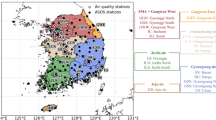Abstract
Air pollution has received much attention in recent years, especially in the most densely populated areas. Sources of air pollution include factory emissions, vehicle emissions, building sites, wildfires, wood-burning devices, and coal power plants. Common and dangerous air pollutants include nitrogen dioxide (NO2), ozone (O3), carbon dioxide (CO2), particulate matter 10 (PM 10) and particulate matter 2.5 (PM 2.5). This study focused on PM 2.5 because it has an aerodynamic diameter less than or equal to 2.5 μm. The small size of this pollutant makes it easily inhaled by humans and may end up deep in the lungs or even the bloodstream. Such pollutants can trigger health problems such as asthma, respiratory inflammation, reduced lung function and lung cancer. The purpose of this work was to forecast the next hour of PM 2.5 based on air pollution concentrations and meteorological conditions. The approach also uses station location data to cluster the area and to determine the neighboring areas of each station. Forecasting is based on the Long Short-Term Memory (LSTM). The result shows that the proposed approach can effectively forecast the next hour of PM 2.5 pollution.
Access this chapter
Tax calculation will be finalised at checkout
Purchases are for personal use only
Similar content being viewed by others
References
MacMunn, A.: More than 4 in 10 Americans live with unhealthy air according to 2018 ‘state of the air’ report. American Lung Association (2018). https://www.lung.org/about-us/media/press-releases/2018-state-of-the-air.html. Accessed 2 May 2019
WHO: Ambient (outdoor) air quality and health (2018). https://www.who.int/en/news-room/fact-sheets/detail/ambient-(outdoor)-air-quality-and-health. Accessed 2 May 2019
Jacobs, E.T., Burgess, J.L., Abbott, M.B.: The Donora smog revisited: 70 years after the event that inspired the clean air act. Am. J. Public Health 108, 85–88 (2018)
Wilkins, E.T.: Air pollution aspects of the London fog of December 1952. Q. J. Roy. Meteorol. Soc. 80(344), 267–271 (1954)
Ganesh, S.S., Modali, S.H., Palreddy, S.R., Arulmozhivarman, P.: Forecasting air quality index using regression model: a case study on Delhi and Houston. In: Proceedings of the International Conference on Trends in Electronics and Informatics, pp. 248–254. IEEE (2017)
Shaban, K.B., Kadri, A., Rezk, E.: Urban air pollution monitoring system with forecasting models. IEEE Sens. J. 16(8), 2598–2606 (2016)
Gu, K., Qiao, J., Lin, W.: Recurrent air quality predictor based on meteorology- and pollution-related factor. IEEE Trans. Ind. Inform. 14(9), 3946–3955 (2018)
Tsai, Y., Zheng, Y., Cheng, Y.: Air pollution forecasting using RNN with LSTM. In: Proceedings of the IEEE 16th International Conference on Big Data Intelligence and Computing and Cyber Science and Technology Congress, pp. 1074–1079. IEEE (2018)
Oprea, M., Mihalache, S.F., Popescu, M.: A comparative study of computational intelligence techniques applied to PM 2.5 air pollution forecasting. In: Proceedings of the 6th International Conference on Computers Communications and Control, pp. 103–108. IEEE (2016)
Chen, Y., Qin, H., Zhou, Z.: A comparative study on multi-regression analysis and BP neural network of PM2.5 index. In: Proceedings of the 10th International Conference on Natural Computation, pp. 155–159. IEEE (2014)
Han, J., Kamber, M., Pei, J.: Data Mining: Concepts and Techniques, 3rd edn. Morgan Kaufmann, Burlington (2011)
Imamura, K., Kubo, N., Hashimoto, H.: Automatic moving object extraction using x-means clustering. In: Proceedings of the 28th Picture Coding Symposium, pp. 245–249. IEEE (2010)
Nathanson, J.A.: Air pollution. Encyclopaedia Britannica (2018). https://www.britannica.com/science/air-pollution. Accessed 9 May 2019
Liu, L., He, G., Shi, X., Song, H.: Metadata extraction based on mutual information in digital libraries. In: Proceedings of the First IEEE International Symposium on Information Technologies and Applications in Education, pp. 209–212. IEEE (2007)
Goodfellow, I., Bengio, Y., Courville, A.: Deep Learning. MIT Press, Cambridge (2017)
Willmott, C.J., Matsuura, K.: Advantages of the mean absolute error (MAE) over the root mean square error (RMSE) in assessing mean model performance. Clim. Res. 30(79), 79–82 (2005)
Lv, B., Cai, J., Xu, B., Bai, Y.: Understanding the rising phase of the PM 2.5 concentration evolution in large china cities. Sci. Rep. 7 (2017). Article number: 46456
Niharika, M.V., Padma, S.R.: A survey on air quality forecasting techniques. Int. J. Comput. Sci. Inf. Technol. 5(1), 103–107 (2014)
Acknowledgments
This study was funded by the Ministry of Science and Technology, Taiwan, under Grants MOST107–2221-E-027–113-, MOST108–2321-B-027–001- and MOST108–2221-E-027–111-MY3.
Author information
Authors and Affiliations
Corresponding author
Editor information
Editors and Affiliations
Rights and permissions
Copyright information
© 2021 Springer Nature Switzerland AG
About this paper
Cite this paper
Adrezo, M., Huang, YP., Sandnes, F.E. (2021). A PM 2.5 Forecasting Model Based on Air Pollution and Meteorological Conditions in Neighboring Areas. In: Yildirim Yayilgan, S., Bajwa, I.S., Sanfilippo, F. (eds) Intelligent Technologies and Applications. INTAP 2020. Communications in Computer and Information Science, vol 1382. Springer, Cham. https://doi.org/10.1007/978-3-030-71711-7_20
Download citation
DOI: https://doi.org/10.1007/978-3-030-71711-7_20
Published:
Publisher Name: Springer, Cham
Print ISBN: 978-3-030-71710-0
Online ISBN: 978-3-030-71711-7
eBook Packages: Computer ScienceComputer Science (R0)




